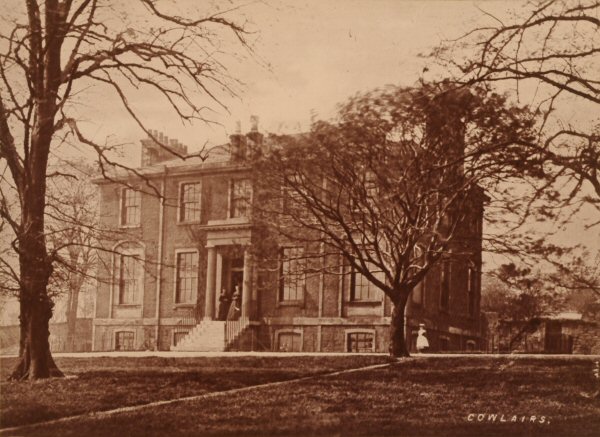

THE lands of Cowlairs are situated about two miles north from Glasgow, on the line of highway to Kirkintilloch, and within the territory of the burgh. Before they were divided, these lands embraced a range of about eighty acres. The solum of what is now the cemetery of Sighthill anciently formed part of one of the farms, and derived its name from the extensive and picturesque prospect of country commanded from the summit, portions of several neighbouring shires being visible.
M'Ure, among the possessions of the Trades' House of Glasgow (in 1736), names "likewise the lands of Cowlairs, with the manor-place, houses, buildings, gardens, parks, enclosures, and pertinents thereof, lying within the Barony Parish of Glasgow."
About the middle of last century, the whole of Cowlairs belonged to Alexander Williamson of Petershill, in the immediate vicinity, who subdivided the estate. Thus, Sighthill and a large adjoining portion of Cowlairs were conveyed by him in 1763 to John Anderson, a wealthy Glasgow merchant. On the remaining part, extending to about forty-five acres, Mr. Williamson built the original mansion of Cowlairs, planted the lands, and laid them off very tastefully, with a row of beautiful lime trees along the approach from Sighthill, which was further adorned with roses and hawthorn, the whole forming a charming country retreat. It is this section of Cowlairs to which the present notice applies.
Mr. Williamson was succeeded by his sons Robert and Alexander, both merchants, who, in 1778, sold the mansion and lands to another Glasgow merchant, Robert Scott, of an old family. He died a few years afterwards, and his brother Allan Scott became proprietor. This gentleman long carried on business under the once well known firm of Bogle and Scott. His youngest son, Michael Scott, was the author of the racy and amusing papers contributed originally to Blackwood's Magazine, but since collected into separate volumes, under the titles of "Tom Cringle's Log" and "The Cruise of the Midge." He was born in the old mansion of Cowlairs in 1789, and educated at the Grammar School and College of Glasgow. (1)
In Richardson's curious map of the districts around this city, published in 1795, Cowlairs House is represented embossed among trees, and quite in the country.
The mansion and lands passed from Mr. Allan Scott in 1813, (2) and then became the property of Mr. John Gourlay, distiller, a staunch supporter of the Whig party in the county of Lanark. He very much enlarged and improved the place. In particular, he purchased about thirty acres of the adjoining lands of Keppoch Hill, which enabled him to open a new and more convenient approach through them from the Port-Dundas Road to the mansion of Cowlairs, the original access from the Kirkintilloch highway having been somewhat circuitous. Near the point on that highway, where the former avenue to Cowlairs branched off, a queerish old cabaret stood, popularly known as "Lodge my loons." It was on Mr. Anderson's portion of Cowlairs, and, it is said, derived its somewhat forbidding soubriquet from the circumstance of a horde of the wild Highlandmen of Prince Charlie's forces having made it their quarters, and harried the neighbouring district, as their leaders did the town.
The original edifice of Cowlairs (3) had a peculiarly quaint appearance, but having been found by Mr. Gourlay somewhat unsuitable, he built a new one in front of the old, as now represented in the photograph. This was in 1824. The property has ever since remained with Mr. Gourlay's descendants, and now belongs to his grand-daughter Mrs. Crichton. But it has been abandoned as a family residence. The N.B. Railway cut the property in two between the house and the offices, and what amenity was left has been destroyed by their great engine works, and by the spread of the city in this as in every other quarter.
(1) This talented citizen was a number of years in Jamaica, and in 1818 espoused a daughter of Robert Bogle Esq. of Gilmorehill. He finally returned to Glasgow, and engaged in mercantile pursuits. It was during this latter period that he wrote the amusing papers above referred to, under the strictest incognito. He died on 7th November, 1835, in the prime of life, and rests in the Necropolis, nearly side by side with his brother-in-law Mr. James Bogle, formerly Dean of Guild, another most worthy and deeply lamented townsman, who died suddenly on the morning of 3rd May 1855, aged fifty-one. Mr. Bogle's ancestors were merchants in Glasgow as far back as the days of Charles II.
(2) The Scotts are now represented here, by Allan Scott's grandson, also Allan Scott, who is grandson through his mother of John Stirling of Cordale.
(3) Cowlairs was long occupied by the late Gilbert Kennedy, whose wife was one of the Scotts. Many must remember the figure of this fine looking old gentleman, almost always on horseback. His father, James Kennedy of Auchtyfardle, was ruined in 1772 by the great bank failure of Douglas Heron & Co. of Ayr. Through his mother, a sister of John Orr of Barrowfield, whose services as Town Clerk of Glasgow are commemorated by a monument in the nave of the High Church, Mr. Kennedy represented the old Glasgow family of the Orrs of Barrowfield and Stobcross.
Back to Contents